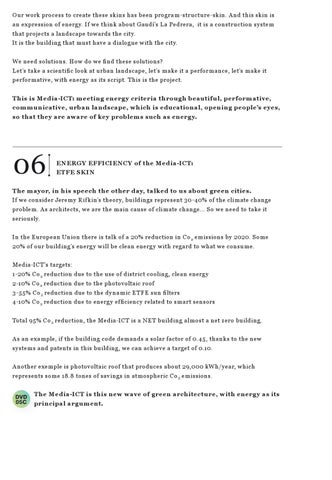Our work process to create these skins has been program-structure-skin. And this skin is an expression of energy. If we think about Gaudí’s La Pedrera, it is a construction system that projects a landscape towards the city. It is the building that must have a dialogue with the city. We need solutions. How do we find these solutions? Let’s take a scientific look at urban landscape, let’s make it a performance, let’s make it performative, with energy as its script. This is the project. This is Media-ICT: meeting energy criteria through beautiful, performative, communicative, urban landscape, which is educational, opening people’s eyes, so that they are aware of key problems such as energy.
06
ENERGY EFFICIENCY of the Media-ICT: ETFE SKIN
The mayor, in his speech the other day, talked to us about green cities. If we consider Jeremy Rifkin’s theory, buildings represent 30-40% of the climate change problem. As architects, we are the main cause of climate change... So we need to take it seriously. In the European Union there is talk of a 20% reduction in Co 2 emissions by 2020. Some 20% of our building’s energy will be clean energy with regard to what we consume. Media-ICT’s targets: 1-20% Co 2 reduction due to the use of district cooling, clean energy 2-10% Co 2 reduction due to the photovoltaic roof 3-55% Co 2 reduction due to the dynamic ETFE sun filters 4-10% Co 2 reduction due to energy efficiency related to smart sensors Total 95% Co 2 reduction, the Media-ICT is a NET building almost a net zero building. As an example, if the building code demands a solar factor of 0.45, thanks to the new systems and patents in this building, we can achieve a target of 0.10. Another exemple is photovoltaic roof that produces about 29,000 kWh/year, which represents some 18.8 tones of savings in atmospheric Co 2 emissions. The Media-ICT is this new wave of green architecture, with energy as its principal argument.
